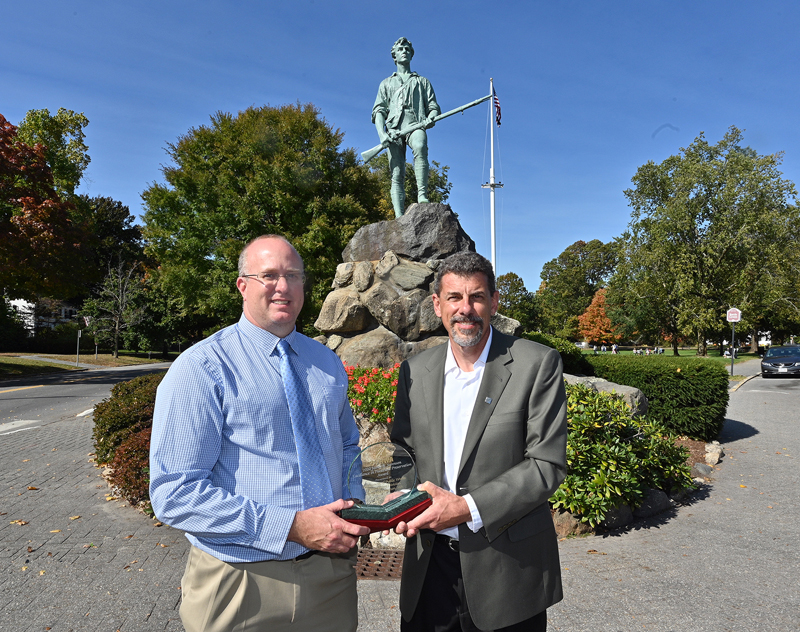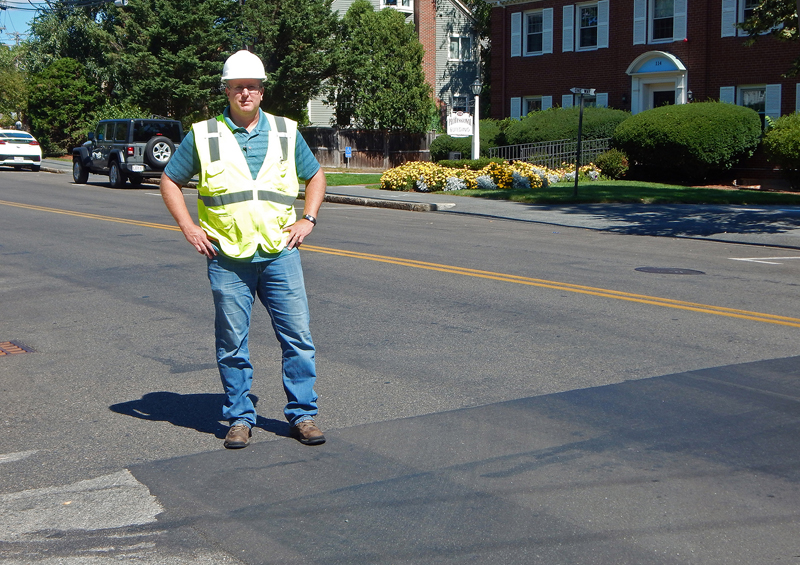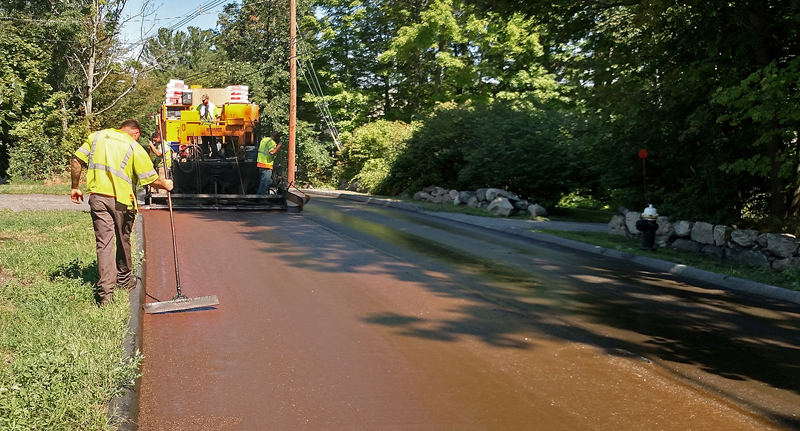
Lexington, Mass., Town Engineer John Livsey, P.E., and FP2 President Scott Bergkamp, with 2020 James B. Sorenson Award for Excellence in Pavement Preservation, at Lexington Battle Green, where on the morning of April 19, 1775, ‘the first blood was spilt in the dispute with Great Britain,’ as Gen. George Washington wrote in his diary
IMAGE CREDIT: Joe Brown Photos
The Town of Lexington, Mass., has been honored with FP2’s James B. Sorenson Award for Excellence in Pavement Preservation for 2020.
The award was presented in October 2020 at the Lexington Battle Green to John Livsey, P.E., Town Engineer, by FP2 President Scott Bergkamp. Lexington Green was site of the first armed confrontation of the American War for Independence, where the “Shot heard around the world” was fired.
Lexington was nominated for the award by indus, formerly Sealcoating, Inc., of Braintree, Mass., in partnership with Lexington.
The Sorenson Award is presented by FP2 to recognize superior pavement preservation practice, usually to a city, township, county or state agency. The deadline for entries for the year 2021 is July 1, 2021.
“The application submitted was judged to be exceptional and indicated the commitment that the town and its staff have made in keeping good roads good, and engaging the traveling public in Lexington with the benefits of their program,” said FP2 executive director Jim Moulthrop, P.E. “Their activities to make constituents aware of the benefits to be accrued using preservation are to be commended.”
“If you have less money, if your budget is being cut, or even just not being increased, it’s the best time to perform preservation,” said Lexington’s Livsey. “The less you have, the more critical it is to really stretch your dollars and make sure that the better condition roads just do not slip.”
MEETS FOUR CRITERIA
The Town of Lexington met all four of four criteria for an award-winning program, the award committee decided.
• Acceptance of the pavement preservation concept by elected officials, general public, employees and industry (40 percent award weighting). Elected officials in Lexington have wholeheartedly accepted town engineer Livsey’s pavement preservation program as the best long-term strategy for cost-effectively providing residents with good roads, the nominators say.
Starting with a network pavement condition index (PCI) of only 68 ten years ago,

At Sorenson awards luncheon Oct. 14 are, from left, Trish Malatesta, Town of Lexington engineering aide; Wayne Medlin, engineering inspector; Scott Bergkamp, president, FP2 Inc.; Matt Weisman, senior civil engineeer; John Livsey, town engineer; Mike Sprague, senior civil engineer; and Chris Lanigan, highway crew chief
IMAGE CREDIT: Joe Brown Photos
the town’s Board of Selectmen accepted the engineering department’s goal of attaining an average PCI in the mid-80s. Since then the town’s Capital Expenditures Committee has support the program and its proposed budget every year.
With the number of resident complaints going down, and the number of “thank you” e-mails going up, Lexington leaders are pleased with the growing public support and appreciation for their pavement management efforts. Internally, town employees have also embraced pavement preservation as the new and right way to responsibly manage the community’s most valuable physical asset.
• Demonstration of the preservation principles by using the Right Treatment, on the Right Road, at the Right Time (20 percent weighting). Ten years ago, prior to implementing its robust pavement preservation initiative, the Lexington annual work program was like many others in New England, and utilized just three primary treatments.
Most funding was spent doing hot mix asphalt (HMA) mill-and-fill, and full depth reclamation (FDR), and any remaining funds were used for crack sealing. Today, with the adoption of a more optimized pavement preservation approach, the Town of Lexington utilizes as many as eight different treatments, each appropriate at different points in time as an asphalt pavement deteriorates.
These treatments include crack seal, fog seals and rejuvenators, micro surfacing, cape seals, 1.5- to 2-in. HMA “Thinlays,” HMA mill-and-fill, cold in-place recycling (CIR), and FDR, with a heavy emphasis on top-of-the-curve preventive maintenance.
To utilize each of these repair and maintenance tools effectively, Lexington is committed to keeping the data in its pavement management system live and up-to-date. The current condition rating of every road segment is estimated annually, including the severity and extent of pavement distresses.
The pavement management program matches the most suitable treatment strategy to each road segment based on these condition ratings, and

In the field, Lexington Town Engineer John Livsey, P.E., stands at threshold of fog seal to rear, and double micro surfacing (“cape” seal) in the foreground
the engineering staff then works with local trusted contractors to confirm and fine-tune the software’s recommended treatment solution for each road.
• Use of communication techniques to keep the public notified about upcoming preservation road work in the area (10 percent weighting).
Of the more than 200 road owner agencies indus works for each year, Lexington’s public notification process is by far the most comprehensive, and is a big part of why their pavement preservation program has been so successful and accepted by the community.
Lexington’s outreach program answers not only the “where” and “when” questions residents want to know to minimize the construction inconvenience, but also answers the “what” and “why” questions people often have when they see different, non-traditional paving methods being used.
At the start of each construction season, residents with property abutting every road being improved receive a letter and a map detailing all the treatments the town has planned for that year.
• Uniqueness of the program, including documenting tangible benefits such as increased useable life of the pavement, new concepts or applications employed, reduced user delays during treatment applications, and decreased frequency of reconstruction and major rehabilitation or reconstruction (30 percent weighting).
Reducing user delays is paramount to public acceptance of pavement preservation treatments, and Lexington is unique in that it goes to extraordinary measures to achieve this goal.
Aside from some of the communication techniques described above, other measures include performing treatments in school zones at night whenever schools are in session, and using its Twitter feed to provide updated construction schedules and detour maps to affected motorists.
The real uniqueness of the Lexington program, though, is the astounding success it’s achieved in a relatively short amount of time. Some of the documented tangible benefits of their commitment to pavement

In 2018 in Town of Lexington, Sealcoating, Inc., now indus, places slurry surfacing atop chip seal on Town of Lexington street
preservation have been:
• Adding net gains of new service life to Lexington’s network in each of the last four years.
• Decreasing the network backlog of all required repairs from a high of $20.35 million in 2012 to $7.25 million in 2020.
• Increasing the average network condition rating from a PCI of 68 in 2010 to an RSR of 85 in 2020 (Lexington’s original pavement management consultant used a PCI rating system and their current consultant uses a Road Surface Rating [RSR] system, which generally is comparable to PCI.
• Reducing the percentage of poorer condition roads requiring major rehabilitation or reconstruction from 39 percent of the network in 2010 to only 15 percent in 2020.
Having accomplished its goal of 10 years ago of reaching an average network PCI in the mid-80s, Lexington has determined it could cut its annual pavement management budget by about $1.2 million and still retain this high average PCI by simply practicing pavement preservation and staying focused on keeping good roads in good condition.
But with residents overwhelmingly supportive of the road program, and excited about the progress made, town leaders have opted to keep the current budget steady and continue to improve their average condition rating.
